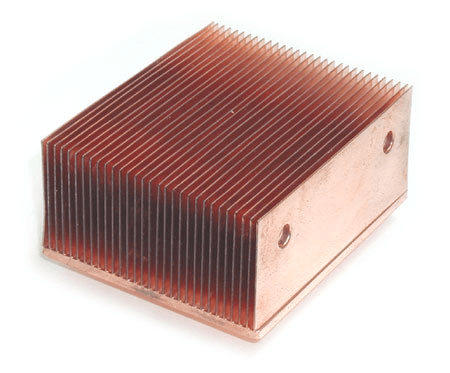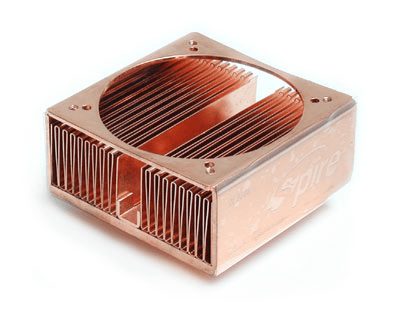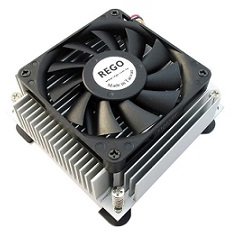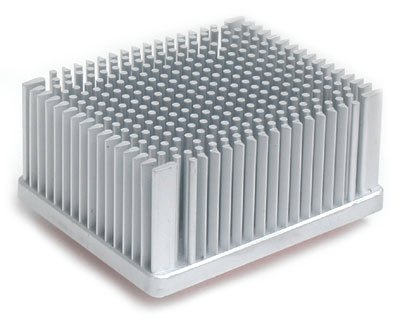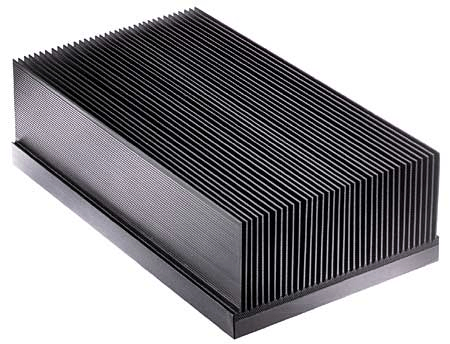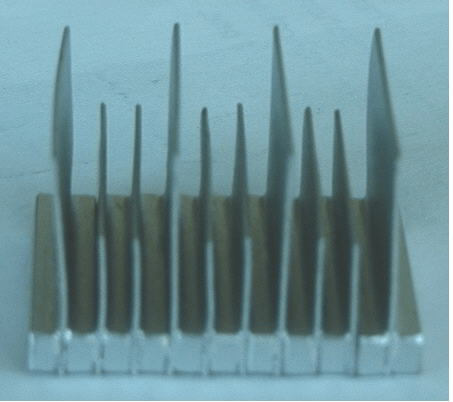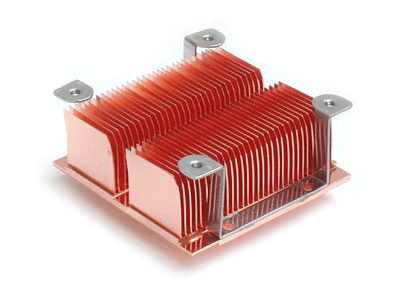Heat Sinks Information

Heat sinks are thermally conductive components or devices that absorb and dissipate heat generated by electronic components. Heat sinks cool high-powered devices to prevent overheating. The reliability of electronic components is generally reduced by the square of an increase in temperature. For example, doubling the ambient temperature around a component renders the component 25% less reliable than at the lower temperature. Heat sinks are therefore essential in dissipating generated heat and improving component longevity.
A list of devices which commonly use heat sinks is found below.
- Computers: central processing units (CPU) and graphics cards. Heat sinks became essential to computers in the 1990s when processor speeds, and therefore the heat generated by the processor, increased exponentially.
- Optoelectronics: light-emitting diodes (LED) and lasers. Cooling is essential in LED and laser use, as device performance and lifespans are functions of their temperature.
- Soldering. Heat sinks were commonly used to protect nearby electronic components during soldering processes, although modern semiconductors can typically dissipate heat without protection. Some components, such as reed switches, still require heat sink protection when in close proximity to soldering.
- High-power semiconductors, such as transistors.
Types of Heat Sinks
Heat sinks are typically classified by production method and form factor. Information about the most prominent types is contained in the table below.
|
Type |
Description |
Applications |
Performance |
Pros |
Cons |
Image |
|
Extruded |
Useful in most situations; easy to automate production after design is completed. |
Many |
Varies |
Low cost |
Limited to dimensions of extruded aluminum |
|
|
Stamped |
Stamped from a single piece of metal; easy to automate production. |
Low-power |
Low |
Low cost |
Poor performance |
|
|
Bonded Fin |
Produced by bonding individual fins to a base; relatively difficult to manufacture. |
Large devices |
Medium |
Available in large sizes |
Expensive |
|
|
Folded Fin |
Fin pitch is optimized for air flow; may be plastic. |
Ducted air |
Exceptional |
High heat-flux density |
Expensive; ducting necessary |
|
|
Active |
Includes a powered fan or blower for air movement; not a viable long-term solution; moving parts wear and break down. |
Emergency or quick-fix situations |
High |
Simple, “Band-aid” solution |
Poor reliability; high cost; recirculation of warm air |
|
|
Forged |
Manufactured by compressing aluminum or copper. |
Many |
Medium |
Low cost |
Limited design |
|
|
Swaged |
Similar to forged heat sinks; manufactured by forming metal to a die. |
High-power |
Medium |
Ideal for power devices |
Heavy and unwieldy; poor flow management |
|
|
Single Fin |
Versatile devices; designed to be employed in tight spaces. |
Most |
Varies |
Lightweight, low profile |
Expensive |
|
|
Skived |
Fins are cut (skived) from a single block of metal (usually copper). |
Many |
Medium-High |
High fin density |
Thick base and high weight; directionally sensitive |
|
Table image credits: IXBT Labs | Kunze | Carlton-Bates | IXBT | Electronics Cooling | Advanced Thermal Solutions | IXBT
Theory and Design
Heat sinks transfer thermal energy from a high-temperature device to a lower temperature medium. This medium is typically air, but may also be water, a refrigerant, or oil.
An excellent, comprehensive video on heat sink design and its relation to electrical design.
Video credit: EEVblog / CC BY-SA 4.0
Heat sink design depends heavily on Fourier's law of conduction; the formula with regards to a single axis (x) is shown below. (It is important to note, as shown in the video above, that Fourier's law is the thermal analog of Ohm's law.)
a4306f9195e443d6b821d0e26c9d0f7e.gif)
where:
qk = heat flow per area and time
k = conductivity constant
A = surface area of heat transfer
dT = temperature difference
dx = material thickness
The image below illustrates the importance of this formula in heat sink design. As shown in the heat flow diagram at the bottom right of the image, heat sinks must have sufficient surface area and thickness to properly dissipate temperature.
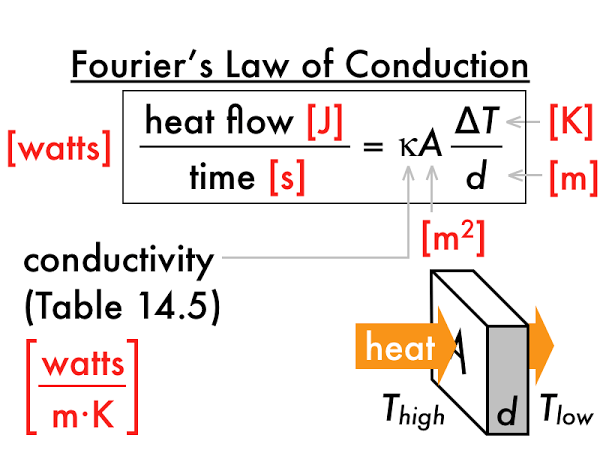
Image credit: Patrick M. Len
The simplest heat sink could consist of a single piece of thermally conductive metal. The protective case of the device containing the heat-generating component could theoretically function as a heat sink as well. However, most heat sinks use fins to increase surface area and create optimal air flow patterns, as shown in the table above.
Material Considerations
Heat sinks are typically constructed using aluminum alloys, most of which have high thermal conductivity values. Copper is considerably denser and more expensive than aluminum, but has superior thermal conductivity, corrosion resistance, and more efficient heat absorption. Various applications and industries, such as power plants, HVAC systems, geothermal heaters and coolers, and electronic systems employ copper heat sinks.
Composite materials such as synthetic diamond, AISIC, Dymalloy, and copper-tungsten pseudoalloy are occasionally used as chip substrates or submounts, which double as heat sinks.
Standards
Heat sinks may be produced, tested, and used according to specific published standards. A list of example standards is found below.
NAS4122 - Extruded heat sinks
SAE AIR1957 - Heat sinks for airborne vehicles
NAS4121 - Formed heat sinks
References and Resources
ATS—Heat sink types: The pros and cons (2 parts)
Sukhvinder S. Kang, "Advanced Cooling for Power Electronics," paper presented by invitation at International Conference on Integrated Power Electronics Systems, 6-8 March 2012, Nuremberg, Germany (pdf).
Image credits:
- Arkansas
- Arizona
- California
- Colorado
- Connecticut
- Delaware
- Florida
- Georgia
- Illinois
- Indiana
- Massachusetts
- Maryland
- Michigan
- Minnesota
- Missouri
- North Carolina
- Nebraska
- New Hampshire
- New Jersey
- Nevada
- New York
- Ohio
- Oregon
- Pennsylvania
- Rhode Island
- South Carolina
- Tennessee
- Texas
- Utah
- Virginia
- Washington
- Wisconsin
- CPU heat sinks
- extruded aluminum heat sink
- copper heat sinks
- extruded heat sinks
- radian heatsinks
- convoluted fin heat sink
- heat sink adhesive
- heatsink to3
- radial heat sinks
- DPAK Heatsink
- 12 volt heat sinks
- air conditioner heat sinks
- aluminum project box heat sinks
- aluminum silicon carbide heat sinks
- amplifier heat sinks
- avc cooling fan heat sinks
- BGA 559 heat sinks
- BGA heat sinks
- bonded fin copper heat sinks
- bridge rectifier heat sinks
- class a amplifier heat sinks
- copper CPU heat sinks
- copper finned heat sinks
- copper laser heat sinks
- copper molybdenum heat sinks
- copper plate heat sinks
- cylindrical heat sinks
- d2pak heat sinks
- diamond heat sinks
- double sided heat sinks


